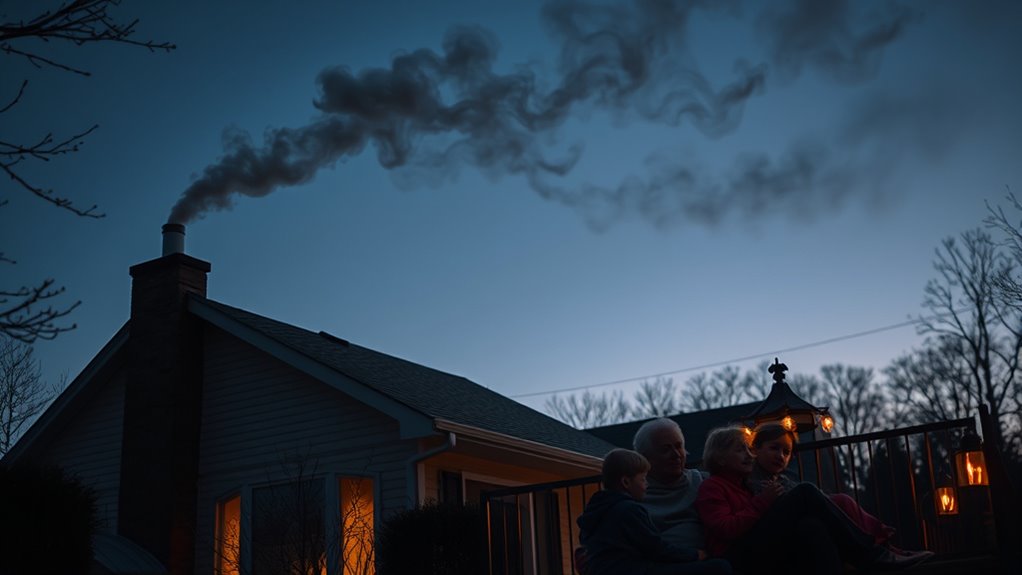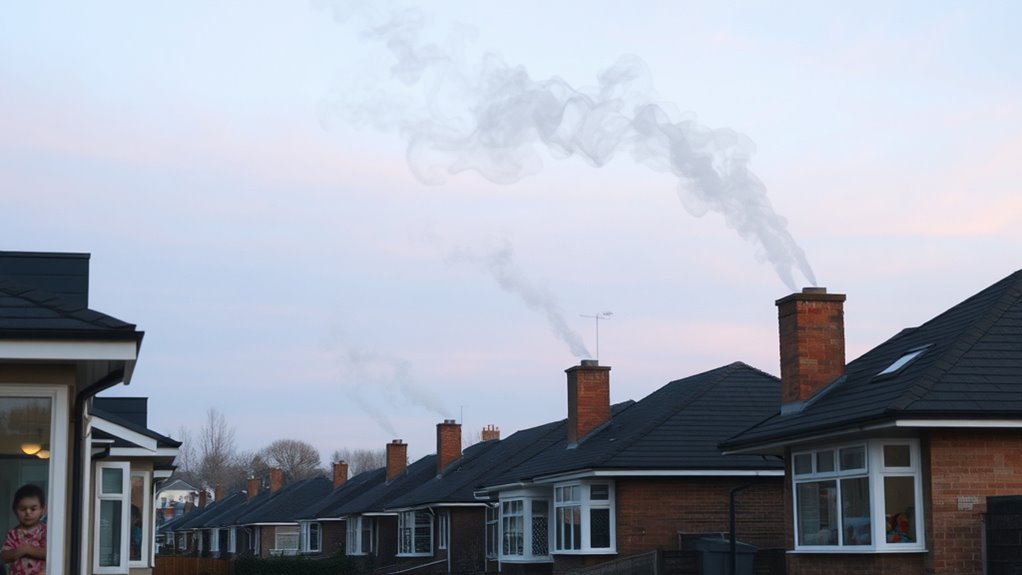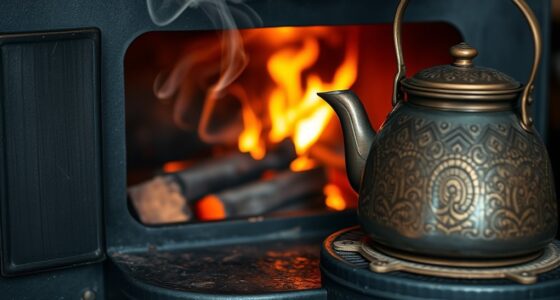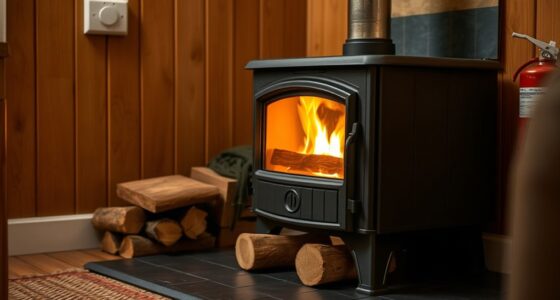If you’re sensitive to indoor air pollutants, residential wood smoke can be especially risky. It releases fine particles and chemicals that can aggravate respiratory issues, harm developing lungs in children, and weaken immune systems in the elderly. Poor ventilation makes these dangers worse by trapping pollutants inside. If you want to understand how to protect yourself and your loved ones from these health hazards, there’s more important information you should know.
Key Takeaways
- Sensitive groups like children and the elderly are more vulnerable to the respiratory and cardiovascular effects of indoor wood smoke.
- Exposure can cause acute symptoms such as coughing, wheezing, and breathing difficulties, especially in vulnerable populations.
- Long-term inhalation of indoor wood smoke increases risks of chronic respiratory and heart conditions among sensitive individuals.
- Poor ventilation and use of traditional fireplaces heighten indoor pollution, disproportionately affecting vulnerable groups.
- Implementing improved stove technology and proper ventilation can reduce health risks for sensitive populations.

Have you ever wondered how your home’s wood-burning stove or fireplace impacts the air quality around you? Many people overlook how indoor air quality can be affected by wood smoke, especially in homes where fireplaces or stoves are used regularly. When you burn wood indoors, tiny particles and chemicals are released into the air, which can linger and be inhaled. These particles, known as particulate matter (PM), are small enough to penetrate deep into your lungs and even enter your bloodstream. Consequently, your indoor environment can quickly become a source of health concerns, particularly for sensitive groups like children, the elderly, or those with pre-existing respiratory conditions.
Research from health impact studies shows that exposure to indoor wood smoke isn’t just an annoyance; it can have serious health consequences. For sensitive groups, the risks are even higher. Children are especially vulnerable because their lungs are still developing, and their respiratory systems are more reactive. Elderly individuals often have weakened immune systems or existing health issues that make them more susceptible to the harmful effects of pollutants. People with asthma, COPD, or other respiratory illnesses face increased risks of exacerbation when exposed to smoke. These health impact studies reveal that even short-term exposure can lead to coughing, wheezing, or shortness of breath, while long-term exposure may contribute to chronic respiratory conditions, cardiovascular problems, and other health issues.
Understanding how your indoor air quality is affected by wood smoke is vital for protecting these vulnerable groups. When you burn wood, you might notice a cozy atmosphere, but you also introduce fine particles and volatile organic compounds into your home. These pollutants can stick around in the air for hours, especially if your home isn’t well-ventilated. Without proper airflow or air purification measures, the indoor environment can become a source of ongoing exposure. If you or your loved ones belong to sensitive groups, it’s important to be aware of these risks and take steps to improve indoor air quality. This might include using cleaner-burning stoves, installing air purifiers, or simply ensuring good ventilation during and after fires. Additionally, emerging research highlights the importance of monitoring AI safety measures in the development of new air quality management technologies to mitigate such health risks effectively.
Frequently Asked Questions
How Can I Reduce Wood Smoke Exposure Indoors?
To reduce indoor wood smoke exposure, guarantee proper indoor ventilation by opening windows or using exhaust fans when burning wood. Always use smoke detectors to alert you to smoke buildup. Keep your fireplace or stove well-maintained and use dry, seasoned wood to minimize smoke. Avoid burning wood indoors when possible, especially if sensitive groups are present. These steps help improve air quality and protect your health.
Are Certain Types of Wood Safer for Burning?
They say “you are what you burn,” and choosing the right types of wood is key for safe burning. Hardwoods like oak, maple, and cherry are generally safer because they produce less smoke and creosote. Avoid treated, painted, or wet wood, as these release harmful chemicals. Using properly seasoned wood guarantees cleaner, safer burning, reducing indoor smoke risks for sensitive groups and making your fireplace healthier for everyone.
What Signs Indicate Health Issues From Wood Smoke?
You might notice health symptoms like coughing, throat irritation, or difficulty breathing, which indicate possible exposure to wood smoke. Watch for exposure indicators such as eye irritation or increased asthma symptoms. If you experience these signs, it’s essential to reduce your exposure by improving ventilation or avoiding wood-burning activities. Recognizing these symptoms early can help prevent more serious health issues, especially for sensitive groups.
Can Air Purifiers Effectively Remove Wood Smoke Particles?
Air purifiers with HEPA filters can effectively reduce wood smoke particles in your home. To maximize their efficiency, you should place the air purifier in a central location, away from walls or furniture that block airflow. While they won’t eliminate all smoke, proper placement and a high-quality HEPA filter markedly improve indoor air quality, helping protect sensitive groups from harmful particles and reducing your exposure to residential wood smoke.
Are There Specific Regulations on Residential Wood Burning?
You should know that regulations on residential wood burning vary by location. Many areas have established wood stove regulations and residential burning policies to reduce pollution. These rules often limit burning hours, specify acceptable stove types, or restrict burning during certain weather conditions. Check your local government’s guidelines to stay compliant and protect sensitive groups from the harmful effects of wood smoke. Following these regulations helps improve air quality for everyone.
Conclusion
You might think burning wood is cozy and harmless, but the truth is, residential wood smoke poses real health risks, especially for sensitive groups. It’s easy to dismiss these concerns as minor, yet evidence shows the dangers can accumulate over time. By understanding this, you realize that small choices—like switching to cleaner heating options—can substantially protect your loved ones. Sometimes, questioning what seems normal reveals the importance of making healthier, smarter decisions for everyone’s well-being.











